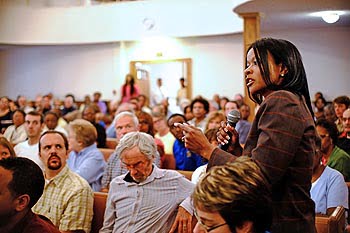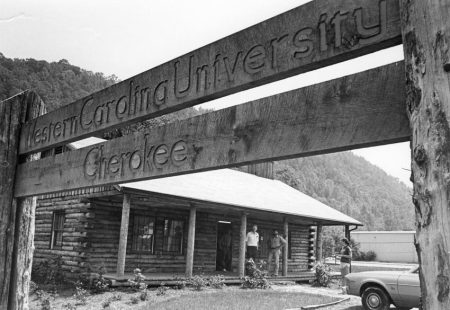A Community Looking for Answers

Community Leaders Talk and Listen to the Public
While most activists and media were paying attention to the legislative shenanigans in Raleigh this summer, and August’s big national news was the Trayvon Martin case in Florida, a number of residents in Asheville decided to draw attention to a local concern that grew out of the national story and could be affected by state actions: how to ensure that a replay of the Florida tragedy does not take place in Western North Carolina. Martin was the 17-year-old teenager shot to death by self-proclaimed neighborhood watchman George Zimmerman, who was acquitted of all charges this summer under Florida’s “stand your ground” law.
By bringing the issue before the public Aug. 15, organizers presented an opportunity for residents to voice the many questions on their minds and address their concerns to law enforcement leaders who can help our community avoid problems like those that plagued Sanford, Florida.
The public event, which grew out of a series of planning meetings conceived by lawyer and long-time rights activist Carol Rogoff Hallstrom, was described as an “interracial interfaith gathering. We have come here deliberately to talk about not just one community in Asheville and Buncombe County, but about matters that concern all of us,” said Rogoff Hallstrom.
“We’re here to explore and understand our rights and responsibilities, as members of a community and as members of law enforcement agencies. What we can agree on is: a young man is dead. So why are we here? Not to retry the Trayvon Martin case, but to explore what it means to our community.”
Among the questions to be addressed were how to:
• Understand NC gun laws
• Know what neighborhood watch groups may, and may not, do
• Understand the rights & responsibilities of law enforcement personnel
• Hold law enforcement accountable as we interact with them
“Most importantly,” said Rogoff Hallstrom, “tonight is about prevention: preventing similar interactions and similar tragedies from happening in our community.”

The panel was comprised of civil rights attorney Frank Goldsmith of Morganton, Asheville Police Chief William Anderson, and Buncombe County Sheriff Van Duncan.
Goldsmith, the first speaker, has been practicing civil rights law for about 40 years. Not only has his practice involved civil rights law as applied to police and law enforcement, but he has also represented law enforcement and served as local attorney for the Fraternal Order of Police in McDowell County. Goldsmith described some of the legal issues that derive from the Trayvon Martin case “not to rehash what happened or determine whether the verdict was right or not, but to use the fact pattern that emerges from that case: an encounter between a 17-year-old unarmed boy on his way home and an armed, untrained local vigilante.
“Legal issues that arise affect both armed law enforcement personnel and armed or unarmed private security, such as neighborhood watch members. The Fourth Amendment, guaranteeing that ‘persons may not be seized except for probable cause,’ governs. So, without probable cause, can a police officer ask a question of anyone on the street such as his name? Can he ask for identification? Can he ask, ‘What’s inside your belongings?’” Not unless he has reasonable cause for suspicion.
Goldsmith also addressed “stop & frisk” laws such as those recently restricted by a judge in New York, after she analyzed 4.4 million stops and learned that some 80% of them involved blacks or Hispanics, and of which only 1.5% resulted in finding a gun. The clear lack of probable cause led her to severely restrict the use of the policy.
Whether such a law would be allowable in North Carolina has not been addressed by courts. But under both NC and U. S. law, probable cause is required for a search, whether with or without a warrant. Furthermore, in the case of Community Watch programs, the concept of a “citizen’s arrest” does not exist in the state—except that, when a citizen sees a felony crime of violence taking place, the citizen may detain the perpetrator without the use of force (for example, by standing in a doorway to block access or egress). Even then, however, the citizen cannot forcibly restrain the perpetrator.
But NC has always had “right of self-defense laws” that allow a resident to use deadly force at home, if an intruder breaks in; and in 2011 the state legislature expanded that right to cover vehicles and the workplace.
Duncan expressed confidence that the best way to ensure that an incident like the Trayvon Martin case does not happen locally “depends on what happened before. Dialogue, understandings, and trust have to be established, both within and around the community,” he said.
The sheriff described the “castle doctrine” of self-defense and its codicil, that one not only cannot be the aggressor, but that every citizen has “an obligation of reasonable retreat: if you have an opportunity to retreat, you have the obligation to do so.”
In the home, however, if someone is breaking in, it is assumed they are there to do harm, and the homeowner can use deadly force inside the house. But even then, if the resident comes outside with a flashlight and gun, and the burglar flees, “your right stops when he flees if you follow him out of the house.”
Duncan noted that the Sheriff’s Department is “extremely supportive of Community Watch programs, which “probably help solve and prevent crimes more than anything else out there. A person keeping an eye out extremely enhances law enforcement by keeping us informed of things we would not know about otherwise.”
But restrictions on Community Watch members are in place, just as they were—though ignored by Zimmerman—in the Martin case. “We would never, never instruct a Community Watch member to follow, track down, or stay with someone they think is breaking the law. They have an issuance from dispatch of what to do: Do NOT follow; do NOT engage. You are eyes and ears, and that’s it.” Because, as Duncan noted, “As you start to engage, bad things happen.”
Chief Anderson chose to gear his message to youth in the community, in great part because so many young people, especially teenage boys and twenty-something men, are less inhibited than more mature adults and are more likely to draw the attention of law enforcement. Anderson also was the only member of the panel to speak bluntly about the Martin case: “The death of Trayvon Martin was a tragedy. In my opinion, it was also a clear-cut case of a police ‘wanna-be’ overstepping his authority.”
But, he noted, “My purpose here is to educate for one purpose: prevention.”
Anderson explained to the young people present, of whom there were only a few, how to “have a positive outcome” in the event of a run-in with law enforcement. (See What To Do If Stopped By Police)
When the microphones were turned over to the audience for questions, speaker Annie Burton identified herself as “a mother and an African American female who has had ‘the talk’ with my boys. And I heard a lot about how one comports themselves with law enforcement and all the data with respect to the number of minorities pulled over for ‘driving while black’. What I want to know is, ‘What kind of measures do you put into place for cultural sensitivity: as we as citizens have to show respect for law enforcement, they must also comport themselves as professionals.”
Both Anderson and Duncan addressed state requirements for diversity and sensitivity training as well as local policies governing the behavior of sworn officers. Goldsmith reminded the audience that “equal treatment is absolutely required under the 14th Amendment: ‘No person shall be denied the equal protection of the laws.’” Under any circumstances where there is no probable cause to justify a stop, there is a legal basis to challenge it.”
Another question was raised about Anderson’s statement that “when pulled over you can deny them to search your car. They have to know they can resist being searched. What do we tell our young people about that?”
Assuming a lack of “reasonable suspicion” when stopped, Sheriff Duncan, who himself has a 17-year-old son, suggested, “Here’s what I’d do: if I thought there was improper or illegal behavior by law enforcement, don’t resist in the street, but comply, and then bring your complaint to the sheriff in the office. They may or may not be acting lawfully, but you can hold them accountable afterwards.”
And, added Goldsmith, “There is nothing wrong with a young person who believes they have been stopped for no good reason from asking the officer, ‘Am I under arrest? Am I free to go?’ If the officer cannot explain why they’ve been stopped, the youth should be free to go.”
Co-convener Oralene Simmons closed the meeting with the assurance that the night’s gathering is only the beginning. “What’s next is the beginning of conversations in other neighborhoods,” she said. “Some concerns may not have been answered tonight. Let’s keep this conversation going long after this forum. The next meeting will be in October, and we need your help to continue this conversation.”
The next public meeting of the
“After Trayvon” committee will take place Tuesday, October 29 beginning at 6 p.m. in the Shiloh Community Center Building.








